How To Hike Half Dome
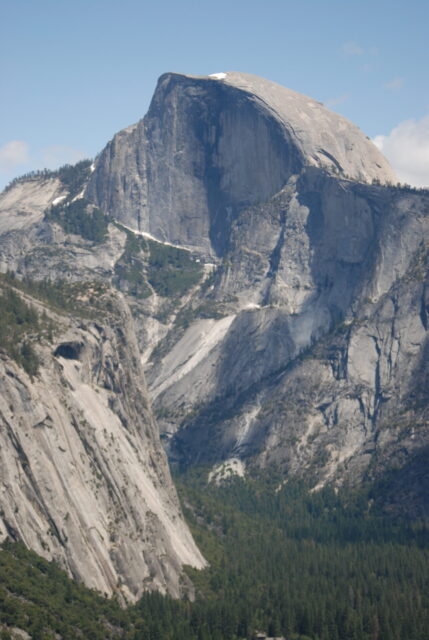
It’s the most iconic hike in California, maybe in the whole country, and it’s on every accomplished hiker’s bucket list. Justifiably so. Not only is the destination very much worth the effort, but the hike itself is spectacular: towering waterfalls, idyllic mountain streams, sublimely beautiful forests, views to the end of the earth, jaw-dropping exposure, and those vertigo-inducing cables. But the hike is not for the faint of heart. Done as a day hike (there are other options, see below) it’s a little over 16 miles round trip with an elevation gain of almost 5,000 vertical feet. Most people do it as a day hike but Half Dome as a backpacking trip is also a great option. Details on the day hike option appear below.
Logistics
The Trailhead – The Half Dome hike traditionally begins and ends at the Happy Isles trailhead. Happy Isles is accessible via the Valley Shuttle Service, stop #16, or by foot from Curry Village. During busy times of the year (which is pretty much any time the cables are up) the shuttle is often very difficult to use. The lines are long, the buses can be completely full and they aren’t very frequent. The signs that say they run every 10 minutes are flat out lying to you. If you are parked or staying at Curry Village you might want to just walk from there. It’s a pleasant .8 miles from the Curry Village parking lot to Happy Isles.
Traffic and Parking – There are 2 good places to park to begin the hike, Curry Village and Trailhead Parking. Trailhead parking is a little closer to the Happy Isles trailhead but is a smaller lot. It is used by backpackers and is often full. The lot at Curry Village also generally fills up but is day use only. You can usually get a spot there (or on the street nearby) if you arrive before 10am (earlier on Saturdays or holidays). Please park in the dirt area leaving the paved lot for Curry Village guests. If these lots are filled you can try the large lot near Yosemite Village or grab a spot on the street further west in the valley.
Weather and When To Hike – The standard plan among Half Dome hikers seems to be to start the hike as early as possible. Many begin well before sunrise and hike by headlamp to get to the top as early as possible. This approach makes sense depending on the weather. First, in July and August it can get pretty hot, especially on the stone steps and cables. Even though they’re at a pretty high elevation, they’re very exposed with no shade. If it’s going to be hot that day you’ll want to get to the top early. Second, afternoon thunderstorms are common in the Sierra. If these are in the forecast make sure you are off the cables well before they start. Rain makes the cables extremely dangerous and lightning has killed people up there. Be extremely careful if there is either in the area.
That being said you might consider another option. Sunset on Half Dome can be magical. The Sierra peaks to the east often light up in amazing yellow, orange, red, and pink Alpenglow. If it’s not too hot and if there are no storms forecast consider starting the hike later in the day. Figure 6-8 hours to get to the top and try to reach it around an hour before sunset. After watching the sunset start down immediately. This should get you off the cables and down the stone steps before dark. The rest of the hike down will be by headlamp but if you stay on the John Muir Trail it’s a pretty safe hike down in the dark.
Water – Depending on the weather, you’ll want at least 3 or 4 liters of water with you on the hike. If you don’t have a water filter there’s only one place to fill up and it’s only about a mile into the hike (just after the first footbridge). You can get away with a little less if you bring a way to treat water. You can tank up safely in several places above Nevada Fall (after mile 2.5). There are a few places where you can reach the Merced River for water below the top of Nevada Fall but be careful. Some of these spots are sketchy and falling in the river is a very bad idea. After you pass the Little Yosemite Valley campground there is no more water. Make sure you have enough when you leave the campground.
Bathrooms – There are several bathrooms along the route. Please make use of them as much as possible. This area sees a ton of traffic and frankly can get a little gross in places. The first bathroom is about a mile into the route just past the first footbridge before the first JMT junction. It’s the last flush toilet on the trail. From here on it’s pit toilets of varying quality only. However, as of 2018 this one is closed due to broken pipes. There is also a water fountain here that is usually open May – October. This is your last chance to tank up with treated water. The next bathroom, a pit toilet that sees lots of use, is located just past the top of Vernal Fall. Look for the sign between the top of Vernal and the Silver Apron. Another is located at the top of Nevada Fall on the north side of the Merced right where the Mist Trail reaches the top. This one is notoriously heavily used and gets pretty bad in the summer. I recommend skipping it for the very nice toilets at the Little Yosemite Valley campground. These high-tech composting toilets are among the nicest I’ve seen in the backcountry. They are usually pretty clean and generally don’t smell too bad. These are the last toilets on the route. After that it’s cat holes. Please, please, please follow Yosemite’s guidelines for cat holes. Dig a hole at least six inches deep, cover your waste, and pack out the used toilet paper. As someone who is on this trail very often, I would greatly appreciate it.
What To Bring – I like to strike a balance between bringing everything I need and keeping my pack weight down. Start with water. As mentioned above you’ll want 3-4 liters with you. Or bring a way to treat water and you can get away with maybe 2 liters to start. Make sure you tank up before you pass the Little Yosemite Valley campground. Next, make sure you have some food. This is a very hard hike and you’ll need fuel along the way. Bring at least 1000 – 1500 calories. Bring your favorite snacks and/or a nice picnic for the top.
As for gear, there really isn’t much you need. A small (travel size) bottle of sunscreen is a very good idea along with a good sun hat. You won’t need much in in the way of 1st aid gear. A basic kit with some band-aids, anti-septic wipes, and an ace wrap is plenty. This is a very well-traveled trail and help is never very far away. And definitely bring your cell phone. If you do need help there is good coverage in many places along the way. Finally, make sure you bring a headlamp or flashlight and spare batteries. This is a long hike and the trail can be pretty dangerous in the dark. If you’re hiking before sunrise or after sunset you’ll almost certainly need a light.
Obviously clothing depends on the weather. From late June to late August it can be pretty hot during the day, even on top, but bring layers. Temperatures can vary by 30 or 40 degrees from day to night. A light down jacket makes a great warm layer to throw on when needed. In early and late season you may want to add gloves, a thermal hat, a heavy down jacket, and thermal base layers top and bottom.
The Cables and A Word About Heights – There’s nothing quite like the Half Dome cables anywhere else in America. Climbing them is a thrilling and unique experience but they are not for everyone. The exposure when you’re on the cables is hard to imagine. On one side it’s 2,000 feet down and on the other it’s almost a vertical mile. And the rock you’re climbing with the help of the cables is steep and slick. People with a fear of heights will probably want to look elsewhere for a hike to do. Even the stone steps, the approach to the cables, can be tough for some people. That being said with a little caution this is a pretty safe hike. Accidents are very rare. Stay inside the cables, exercise caution when passing, and don’t go when it’s wet and you’ll be fine.
Permits
A permit is required to climb Half Dome any time the cables are up. The National Park Service generally tries to get the cables up by the Friday before Memorial Day and leaves them up until Columbus Day but that can vary depending on conditions. Half Dome permits are given out by lottery at 2 different times: pre-season in March and daily lotteries. To enter the lottery you must go to Recreation.gov. For the preseason lottery, enter any time in March. Enter your info, choose up to 7 dates, pay your $10, and cross your fingers. For the daily lottery enter 2 days before the day you want to hike. Note all members of your hiking group must enter and win the lottery in order to hike. And you will be checked for you permit. If yo don’t have one, don’t go. The rangers have little patience for people trying to talk their way through.
It can be difficult to get a Half Dome day hike permit but if you really want to go up the cables there is an easier way. There are 300 permits available each day but 75 of those are set aside for backpackers. Consider doing Half Dome as part of a backpacking trip. Sometimes it is much easier to get a Half Dome permit as part of your backpacking permit. See my backpacking Half Dome page for details. Or consider a guided Half Dome backpacking trip. My employer, Wildland Trekking offers guided backpacking trips of 3 or 4 days to Half Dome. As a guide I’m probably biased but a guided trip can be a fun, hassle free way to go.
The Half Dome hike starts at the Happy Isles trailhead in the back (East end) of Yosemite Valley. From the Happy Isles shuttle stop cross the Merced River bridge (the Merced will keep you company for much of the hike) and turn right. Enjoy this last bit of flat trail with the Merced River on your right. Note the sign indicating the beginning of the John Muir Trail on your left. Just past this sign the paved trail starts uphill and pretty much stays that way to the top of Half Dome. At about the 1/2mile point, where the trail makes a sweeping left turn, look up and to the right for a distant view of seldom seen Illilouette Fall. Shorty after this, you’ll come to a bridge over the Merced. In the middle of the bridge look left for your first view of Vernal Fall. Just past the bridge there are a water fountain and restroom that may or may not be open. The water fountain generally opens in late May but the restroom has been closed for a few years due to busted pipes.
Shortly after the bridge you have a choice of routes: turn right to stay on the John Muir Trail or continue straight to take the Mist Trail. The JMT is a little longer than the Mist but is MUCH less crowded and generally drier in the spring. It switchbacks rapidly up the side of the canyon wall to Clark Point, well above the top of Vernal Fall. It’s a good option, especially if you’re hiking in the dark, but far less dramatic then the Mist Trail. The Mist Trail continues to follow the Merced upstream toward the base of Vernal Fall. Here you leave the paved trail behind for a long series of rocky steps and uneven trail carved out of the rock. The fall comes into full view now. As you ascend the 600 vertical feet of mostly stairs, depending on the flow of the river at the time, you may start to get wet from the waterfall. It’s called the Mist Trail for a reason. In May and June of wet years you can count on almost becoming one with the waterfall. Not only is the water ice cold but the trail, which is pretty much just large uneven stairs here, can also be extremely wet and slippery. Be very careful when it’s wet. .The trail continues up past the right side of the fall. Stop here for an amazing photo op. There is often a rainbow in the mist at the fall’s base. Continue up he stairs to the top, turn left, squeeze between the granite wall and the railing and continue the short distance to the top of the fall. The big sunny granite slab at the top of Vernal Fall makes a great place to grab a snack, take a break, and maybe dry off. Don’t forget to take a look over the edge of the fall at the railing near the river.
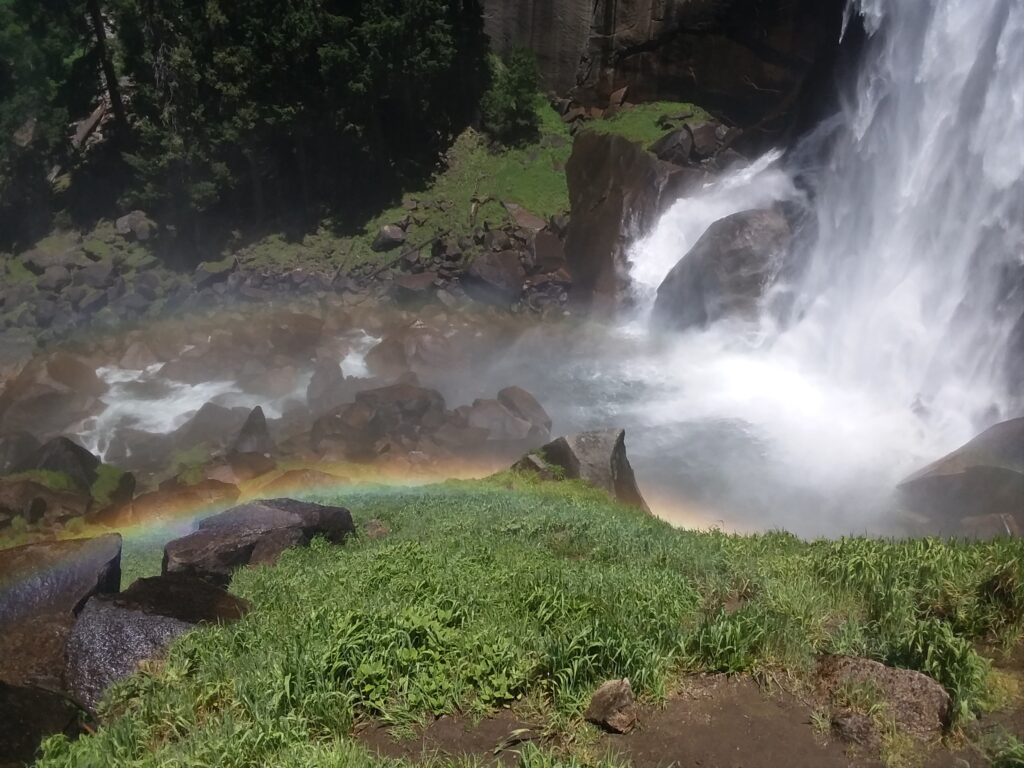
When you’re ready to keep hiking, follow the edge of the river upstream just a few hundred feet or so then turn right just past the bathroom. The trail is a little indistinct here. Just make sure you are moving away from the river after the bathroom. Very shortly you reach a junction and have another route choice. Turn right to take the spur trail up to Columbia Point and rejoin the JMT. This route is a little longer but it avoids a pretty steep staircase on the Mist. If you go this way don’t miss the stunning view of Vernal Fall on the way up. Look for the short spur trail to the right about 1/4 mile past the junction to maybe the most picturesque views of a waterfall to be had in Yosemite. Continue 1/4 mile past the viewpoint to the junction with the JMT. Take a moment to enjoy the view of Nevada Fall, Liberty Cap, Mt. Broderick, and your first good view of (the back of) Half Dome. Turn left to continue. The views of Nevada Fall get better and better as you approach the top. Eventually you cross the Merced on a footbridge right at the top of the fall. Pause here for a minute for a vertigo-inducing view of the Merced River rushing over the edge of the cliff. About 200 feet after the bridge walk up the granite slab on your left, past the large boulder, and down a few steps to an even better view off the top of the cliff.
To take the Mist Trail to the top of Nevada Fall turn left after the Vernal Fall bathroom. This route crosses the Merced on a footbridge then climbs a steep, uneven, rocky staircase up the canyon wall directly beside Nevada Fall to the top of the fall. Nevada Fall thunders away just to your right as you climb. You may get a little wet here but nothing like lower down below Vernal Fall. At the top turn right to take in the view from the top of Nevada Fall, a easy couple hundred yards away. Otherwise, turn left to pass the bathroom and continue up toward Half Dome.
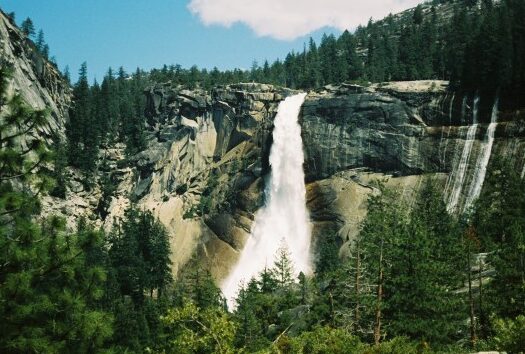
My recommendation is to take the Mist on the way up and the JMT on the way down. Both routes offer dramatic views but they are very different. You really want to see them both. On the way down all the steps on the Mist can be a real knee killer. You’ll be tired and will appreciate the easier grade of the JMT. Once at the top of Nevada Fall there is only one way to go. No more thinking, just one foot in front of the other.
From the bathroom at the top of the Mist the trail makes a rough but moderate climb just a few hundred feet, paralleling the Merced. From here comes what I call the merciful mile, about a mile of slight downhill and flat terrain with pretty smooth trail. After the steep rocky uphill of the Mist Trail or JMT this is a welcome respite. Veer left at the signed trail V. About .4 miles later you come to the very nice bathrooms at the Little Yosemite Campground. Use them. This is your last bathroom.
Once you leave the LYV campground it’s all uphill. Note the sign reminding you not to forget your permit as you begin the ascent. Next is a moderate ascent of about 800 feet over 1.2 miles through a lovely mixed forest of Jeffrey pine, Ponderosa pine, incense cedar, and red fir. At the junction the John Muir Trail turns right but you’re going left. The trail continues to ascend through the forest for another 1.5 miles and 1800 feet before topping out on a ridge at the base of Half Dome proper. Take a few minutes to enjoy the expansive views of Little Yosemite Valley, Cloud’s Rest, and the Clark Range to the east ad Snow Creek Falls across Tenaya Canyon to the north.
After a few hundred yards of nice flat walking on the top of the ridge things begin to get interesting. This is where the stone steps begin (and the rangers often hang out to check permits). The stone steps are a series of about 400 stairs carved into the granite on the shoulder of Half Dome (called Sub-Dome). The stone steps are physically challenging and very exposed. You’re looking down a couple thousand feet on one side and almost a mile on the other. Many people with heights issues call it good only a short way u this section. There’s almost no shade here as well so you really don’t want to be here at mid-day on hot days. Near the top the stairs peter out so you end up walking up a steep granite slab. Just keep going up. You’re on almost a knife-edge ridge so you can’t get lost. Once you top out on Sub-Dome you’ll come face to face with the world-famous Half Dome Cables.
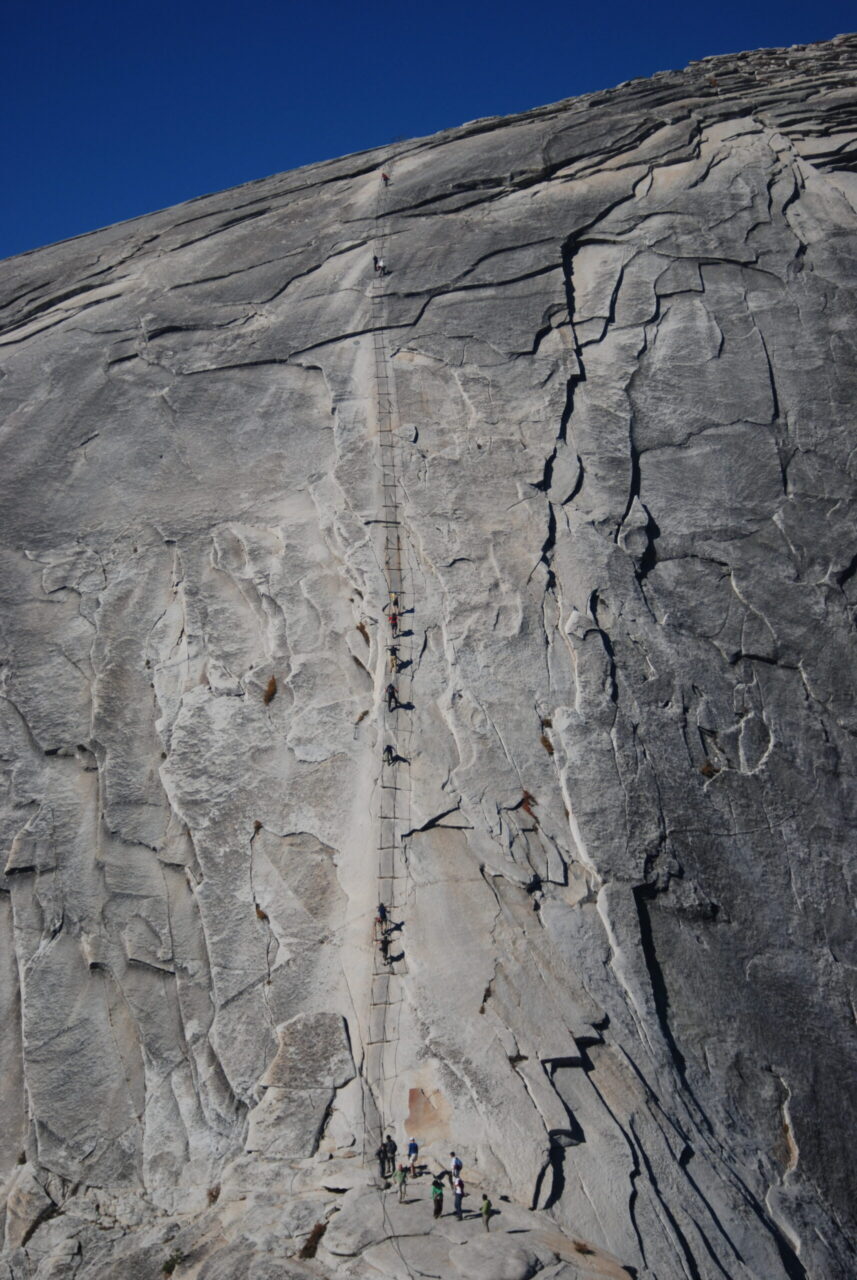
By this point you’ve come an awful long way (8 miles). It’s time to go up the cables. You’ll want to put on your gloves and ditch your trekking poles here (stash them behind the big rock on the left). Then grab one cable in each hand and start working your way up. Only the fittest of the fit can power up the 440 vertical feet of the cables without a break so you’ll probably need a rest. The trick is to rest on the nice flat boards that stretch between the poles. Your calves will be burning if you rest too often on the steep granite between the boards. The boards are also the best place to pass other climbers, whether they’re going your direction or the other way. Communication is key. Talk to the other climbers. Let them know you want to pass, or that you’re going to let them pass. When passing, grab one cable with both hands until you’re clear. It’s pretty tight inside the cables so you want a good grip when someone goes by. Don’t be in a hurry, and DO NOT go outside the cables. And once again, if it’s wet, or if there’s lightning in the area, absolutely DO NOT GO! Climbing the cables when it’s wet or especially with a chance of lightning is a very good way to die.
When you reach the top make your way up and to the right. The best views from the top are north and east from here, across and up into Tenaya Canyon. You also get a spectacular view west into the heart of Yosemite Valley. Don’t miss the small cave out at the end of the Diving Board, the small bit of rock sticking out to the north. The cave entrance is close to the very end of the point, right at your feet. It’s much safer to climb down in there than it looks. Finally, for the best photo op, stay on the end of the point and have someone else take your pic from the top of the dome to the east.
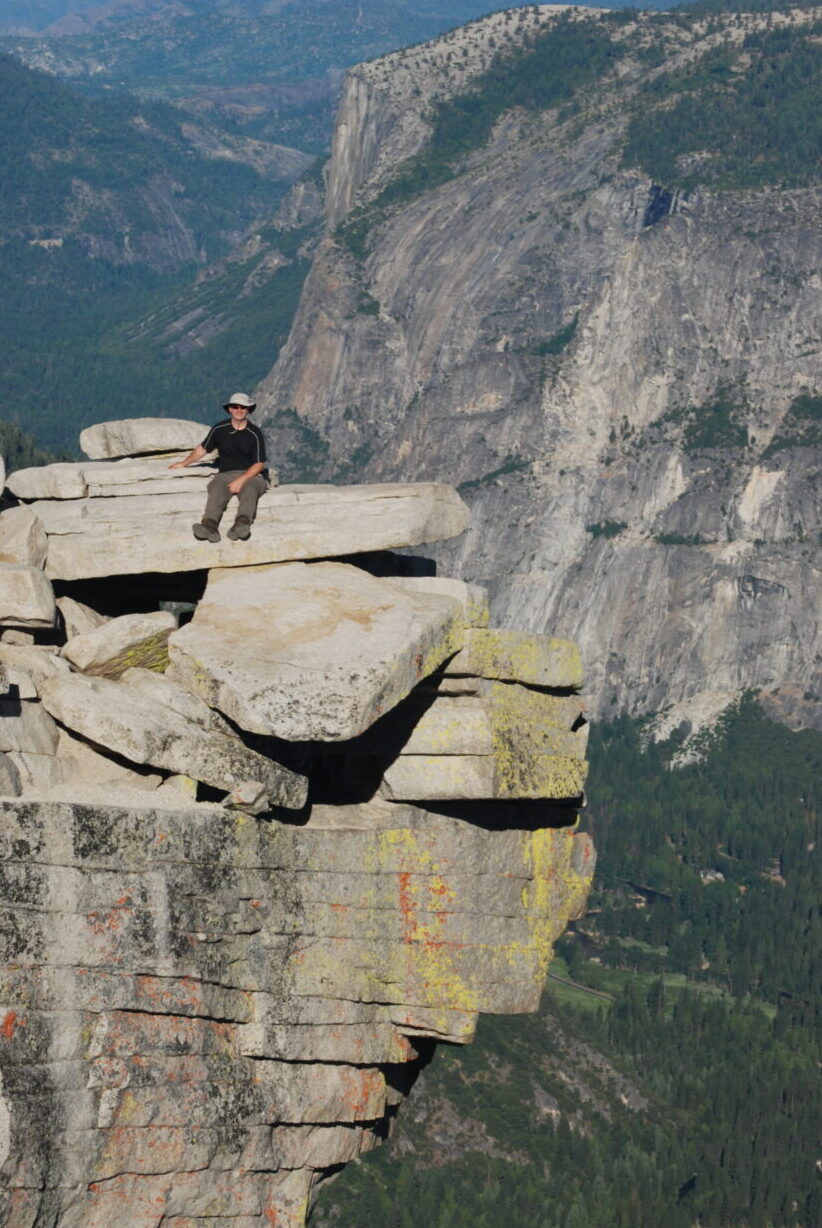
Be sure to take some time to enjoy the top of the dome before you head down. Too many people just tag the top and turn around. It’s an amazing place up there. When you’re ready, head back to the top of the cables. The big question for going down is forward or backward? I can’t say I have a preference. My advice is to try both near the top before it gets steep. Again, take your time, communicate with the other climbers, and rest on the boards. Once you reach the bottom grab your poles and head back down.